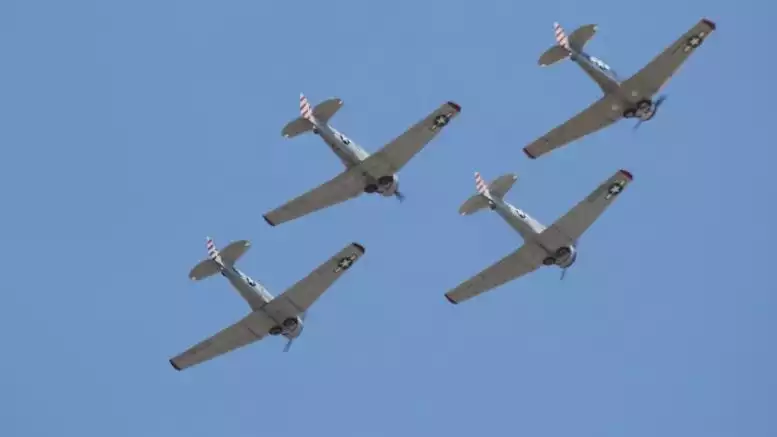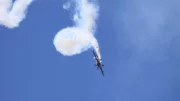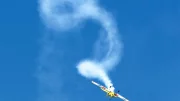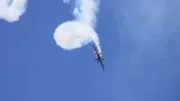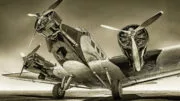An Introductory Guide to Formation Flying
Formation flying demands a great deal of speed, practice, and skill, as well as being mentally and physically challenging. Learn the history, preparations needed and more!
When the general public thinks of formation flying, most people picture the fancy camera-friendly moves performed by the Air Force Thunderbirds or the Navy Blue Angels. However, formation flying is nothing more than two aircraft travelling together in a coordinated manner which has been previously synchronized. They might be matched to the moment and within inches, as is seen in an airshow, or simply keeping close visual contact.
What is Formation Flying?
The types of formation flying seen at airshows is almost always tight and harmonized.
This kind of formation flying requires a great deal of precision control and practice, but experienced pilots who have strong aircraft control and who can coordinate carefully are able to fly in a more informal formation.
Formation flying is often used to sharpen aviation skills, provide assistance or support during long cross country journeys, and to undertake aerial photography. The ability to fly in formation is always handy, especially when meeting up with pilot friends at a fly-in, assisting with moving aircraft out of the path of a hurricane, or deciding to take a short group trip to a nearby airport.
The History of Formation Flying
Like many advancements in aviation, the history of formation flying was propelled by war. It first developed during World War I, which began shortly after the initial Wright Brothers flight. This was the first major conflict in which aviation was a major factor. Both single pilot fighter aircraft as well as reconnaissance airplanes were used, not to mention dirigibles, zeppelins, and hot air balloons. Fighter to fighter combat also began.
In order to protect the reconnaissance airplanes, the fighters provided escort and weapons support. Formation flying was necessary for all of these offensive as well as defensive maneuvers; it was simply safer for the pilots to fly together. By the time the end of the war was approaching in 1918, fighter formations was an accepted practice, and aircraft almost never ventured out alone. Germany’s air force provided some of the earliest rules regarding flying in formation.
After WWI
After World War I, pilots who flew for military missions had the opportunity to revolutionize and practice the most effective patterns of formation flying. Barnstorming in the 1920s and the development of air shows increased interest in aviation, and flying ceased to be viewed as a dangerous stunt and more a safe part of everyday life. Airlines began to transport passengers. Civilian aircraft began to fly in “gaggles” as pilot comrades moved together in a group.
The development of the jet engine meant that even more attention was paid to precision flying. As various maneuvers became possible due to the jet engine’s ability to thrust vector, post World War II formation flying became tighter and concentrated on Cold War reconnaissance. The modern era of formation flying is often demonstrated at air shows by elite military teams, when relative positions are maintained and designs such as diamonds or delta formations are executed. Dynamic patterns make for dramatic demonstrations of precision flying.
Who Is the Flight Leader and the Wingmen?
The success of the formation often depends on the skill of the flight leader. Unless a military decision has been made to place a certain pilot in command, the flight leader is usually the pilot who has the most experience. No matter how many other pilots are present, they are all known as “the wingmen.” To maintain safety and good organization, the wingmen must follow the decisions and positions of the flight leader. Staying with the leader is known as “position keeping.”
When there is only one wingman in a formation of two, the wingman maintains a constant distance by keeping aligned with the leader’s aircraft visually. In the event there is more than one wingman, the other airplanes are used to hold position. It is important for the whole squadron to work together and maintain a safe distance.
Before the Flight, Mission, or Show
Flying so close together is certainly possible by keeping relative speed the same, but doing so can be dangerous. If pilots in a formation have not flown together before or rehearsed as a team, they must have a detailed and extensive briefing to discuss how the flight will unfold and what the forms of communication will be. Pilots must strictly adhere to these procedures.
During a formation briefing, wingmen ask questions and the leader ensures that all understand the movements which will take place. Protocol generally calls for only the leader to speak on the radio. The pilots otherwise can communicate via nodding, hand signals, or even using the aircraft itself to signal a change in altitude or attitude.
Flying Formations
Sometimes, formations break into smaller units. These are usually known as “sections” and have their own leaders and single wingman. When two sections work together, they are known as a “division.” When the formation divides into these smaller groups, they can arrange in a lot of different ways:
- Echelon: Leader in front with all the wingmen on one side behind the leader.
- Line Abreast or Wall: Leader in the center with other aircraft evenly arrayed on either side
- Vee/Vic: Leader in the center, other aircraft equally spread out behind
- In trail: Wingman flying behind and beneath the leader
- Diamond: Leader is in front (the “slot”) and wingmen are arrayed on either side, just behind
- Finger four: Four airplanes spread out with one to the leader’s right and two on the leader’s left
The advanced skills of fighter pilots make them ideal for such demonstration teams as the Blue Angels and Thunderbirds. These teams consist of fighter pilots who are adept in landing on aircraft carriers, or performing maneuvers at high speeds with quick stops. They are used to G forces after rapid acceleration and can perform barrel rolls, loops, and tight designs, usually with a trail of smoke oil so that the crowd can follow them in the sky.
Not only does this kind of flying demand a great deal of speed, practice, and skill, it is also demanding mentally as well as physically. Check out our Wings Over Camarillo Air Show schedule!
Ready to Soar with Us?

